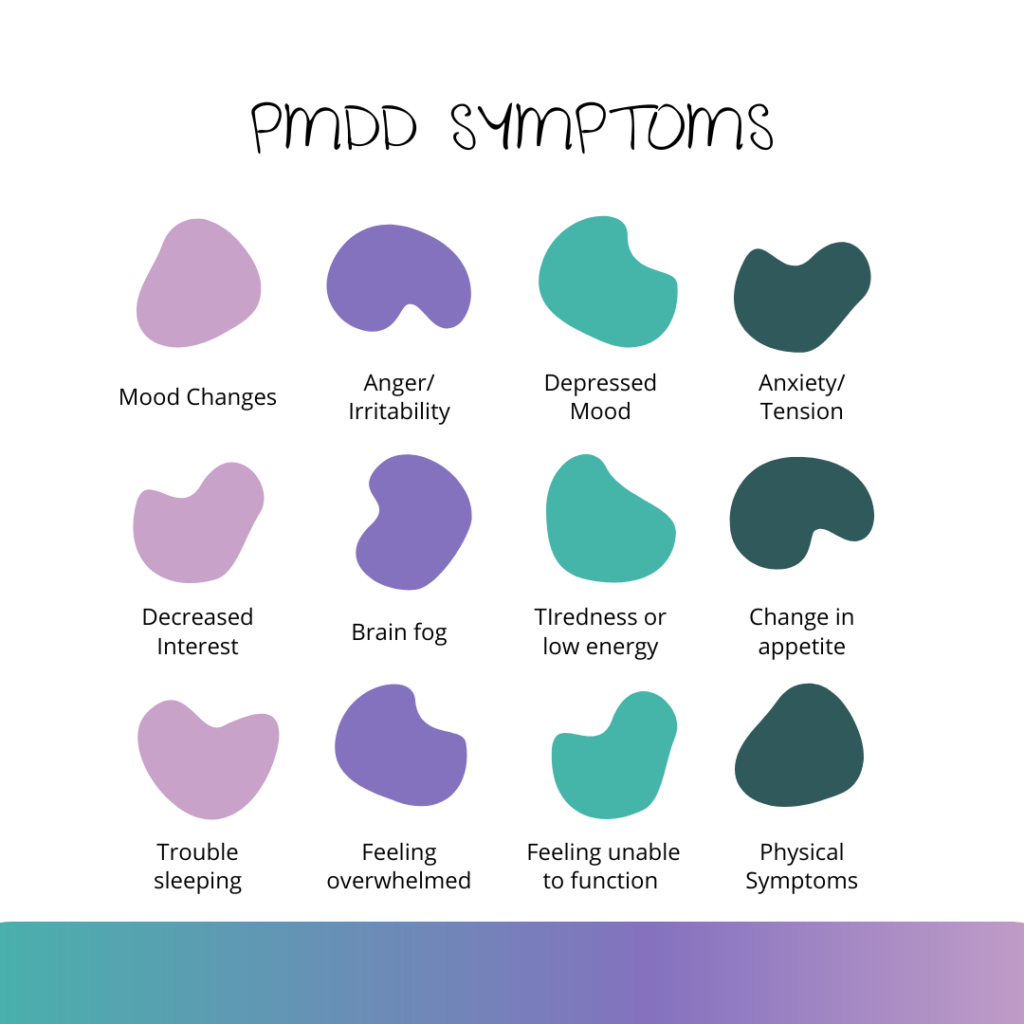I know firsthand how mood swings from your period can deeply impact both your life and your relationships. The guilt of not always being in control of your emotions can weigh heavily, especially when those around you are affected.
While the whole spectrum of emotions has its place, sudden and extreme mood swings could signal something more, like premenstrual dysphoric disorder (PMDD).
In this article, we’ll explore the connection between your menstrual cycle and mood changes, how to identify when they become problematic, and steps you can take to manage these challenges. You’ll also find guidance on when to seek help and strategies to relieve the monthly emotional rollercoaster.
What are Mood Swings from Periods?
In talking with friends and colleagues, I quickly learned that not everyone experiences mood swings in the same way—or at all. While many women notice emotional shifts before their period, others may not recognize the intensity or patterns that can occur during the second half of the menstrual cycle.
Hormonal fluctuations are a key factor. During this phase, levels of estrogen and progesterone rise and fall, directly influencing brain chemistry. These shifts can lead to noticeable changes in your mood, making you feel:
- Sad
- Irritable
- Angry
- Anxious
These hormonal changes also disrupt the balance of serotonin, a neurotransmitter that plays a crucial role in regulating mood, sleep, and appetite. As a result, you might find yourself more emotionally reactive or sensitive than usual.
Mood swings from your period can range from mild to severe, depending on individual hormone sensitivity and other factors.
Recognizing these patterns is the first step in understanding whether your mood changes are typical or could be part of a condition like PMDD.
Do I Have PMDD?
Not all mood swings are created equal. While many women are familiar with the emotional rollercoaster that comes with their cycle, the intensity and impact can vary greatly.
For some, mood swings from periods are a minor inconvenience—something they can brush off with a laugh and move on (“Mood swings? Ha, I laugh in the face of mood swings!”). But for others, these emotional shifts can become overwhelming, affecting work, relationships, and overall well-being. If your mood swings are interfering with daily life, it’s time to ask yourself a crucial question: Do I have PMDD?
Symptoms to Look Out For
The good news? PMDD (Premenstrual Dysphoric Disorder) is recognizable once you know the signs. There are 11 key symptoms to track:
Core Symptoms:
- Intense mood swings or emotional sensitivity
- Irritability or anger
- Feelings of depression, hopelessness, or being down
- Heightened anxiety or tension
These core symptoms are often accompanied by others, which might include:
- Decreased interest in usual activities
- Difficulty concentrating
- Fatigue or low energy
- Changes in appetite, such as overeating or food cravings
- Disrupted sleep patterns
- Feeling out of control or overwhelmed
- Physical discomforts, like headaches, bloating, or joint pain
If you are still unsure if your mood swings signal PMDD, you can do a self-screen.

PMDD vs. Regular Mood Swings
The key to distinguishing PMDD from regular mood swings is recognizing the pattern. PMDD symptoms typically emerge in the second half of your cycle—between ovulation and the start of your period.
Within this window, you may notice different patterns. Some women experience a surge of symptoms around ovulation and another spike 3 to 7 days before their period. Others may feel symptoms consistently for 10 to 14 days.
The intensity is another defining factor. Mood swings from your period can be sudden, severe, and seemingly irrational, often leaving you feeling stuck in a whirlwind of emotion.
PMS vs. PMDD
At this point, you might be wondering: Am I confusing PMDD with PMS? Let’s clarify the difference.
While PMDD and PMS (Premenstrual Syndrome) are often used interchangeably, they are distinct conditions. Unfortunately, the vocabulary surrounding premenstrual experiences can sometimes blur the lines, with both women and doctors using “PMS” to describe what might actually be PMDD.

PMS is generally better understood and tends to involve more physical symptoms, such as bloating, headaches, back pain, and acne, alongside milder emotional changes. PMS is typically less intense, and often doesn’t require medical treatment, as its symptoms can be managed with lifestyle changes or over-the-counter solutions.
Understanding PMDD
Definition and Causes
Premenstrual Dysphoric Disorder (PMDD) is a severe, abnormal reaction to the natural hormonal fluctuations that occur during your menstrual cycle.
While it does affect your brain, it’s important to note that PMDD is not a psychological disorder.
There’s a physical basis for the mood swings from your period—your brain is reacting differently to the hormonal changes, which leads to the emotional and physical symptoms.
Researchers are still working to uncover the exact mechanisms behind PMDD. The current understanding is that it likely stems from a combination of genetic, hormonal, and environmental factors. While we don’t yet have all the answers, we do know that PMDD has a real, biological foundation.
The Diagnosis Process
If you’ve read this far and think the mood swings before your period could be PMDD, you’re probably wondering how to confirm it. Unfortunately, there’s no straightforward PMDD test. The only reliable way to get a diagnosis is through careful tracking of your symptoms over time.
For a diagnosis, you’ll need to log your symptoms for at least two consecutive menstrual cycles. This will help identify the cyclical nature of your mood swings and emotional shifts, which is a hallmark of PMDD.

It’s also essential to rule out other possible causes. Schedule a visit with your healthcare provider to check for physical conditions that could be contributing to your symptoms. Common tests include screening for vitamin deficiencies and evaluating thyroid function—imbalances in these areas can sometimes mimic PMDD symptoms.
How does PMDD affect your family?
Let’s be honest—PMDD doesn’t just affect you; it impacts your relationships, especially with those closest to you. Since they live with you, they experience your monthly emotional shifts firsthand, sometimes feeling like they’re interacting with a different person during your most difficult weeks.
The emotional rollercoaster of PMDD can make your responses unpredictable. You might feel more easily frustrated, quick to anger, or on the opposite end of the spectrum—depressed and completely withdrawn. This can leave your family feeling confused or unsure of how to interact with you during these times.
During these “bad weeks,” you might find it harder to contribute to household chores or parenting duties. This can lead to feelings of guilt, especially if you feel like you’re retreating from your children or distancing yourself from family life.

The good news is, studies show that when a partner understands PMDD and offers support, it can lessen the severity of symptoms and improve overall relationship satisfaction. Support from loved ones truly makes a difference.
A first step towards getting support from your family is opening up the conversation about PMDD. Sit down with your loved ones and explain the symptoms of PMDD, what they look like for you, and how they affect your ability to contribute to family life during those tough weeks.
Set clear expectations and make agreements in advance about what you can and cannot do during those times. This helps ensure your family knows what to expect and creates a sense of teamwork and understanding in the household.
Strategies for living with PMDD
Now that you know what PMDD is and how to evaluate your symptoms, you’re likely wondering what you can do to manage the mood swings from your period.
PMDD does not have a one-size-fits all solution. There are several things that can provide relief, such as:
- Lifestyle Changes and Supplements
- Medical Intervention
- Cultivating resilience
More articles about living with PMDD are coming, but for the moment, let me point out one special tool, that I highly recommend:
Prepare a “mood swing kit” for those tough moments. This can include two parts:
Create a Mood Swing Kit
1. A plan: Work with your family to create a simple action plan for when symptoms hit. Ask yourself questions like: Do I need sleep? Food? Medication? Should I talk to someone? Call a doctor?
2. A comfort box: Fill it with comforting items—a favourite blanket, a journal, or stress-relief objects. Having familiar, soothing items nearby can help ground you in moments of distress.

More tips on how to manage your mood swings are coming soon. I hope that this article helped you understand your mood swings better. What else would you want to know? Share it in the comments.


